
Seoidín O'Sullivan standing in her bedroom with work space on the right
Seoidín O’Sullivan is an artist based in Dublin, Ireland. Her art practice investigates sociopolitical and ecological narratives, which she represents in critically engaged and poetic ways.
Working within a group—an art community or with a fellow artist—is an essential parameter of Seoidín’s work. Her creative manifestations are tangible and serve as the departure point for our conversation. Seoidín’s energy is invested in sustaining her collaborations and projects by sharing her views, beliefs, and ideals of a creative society with an extensive community.
It gives me great pleasure to talk to Seoidín about her practice, as I have been following her work for a decade now. Seoidín opened her home to me and generously let me into her world. Read on and acquaint yourselves with this artist.
Georgia Kotretsos: What’s the main focus of your work?
Seoidín O’Sullivan: I am interested in collective dreaming and believing and issues of land ownership; collective organizing and the commons emerge. I am interested in grassroots forms of organizing, in communities feeling empowered and taking ownership and responsibility in and for their localities. I wanted to see these ideas in practice rather than as mere theory, so I created The Community Garden project. I felt so much relational art that I saw and read about was tokenistic. It seemed to coopt ideas from grassroots collectives and activism—take a photograph of this community and move on. I am interested in sustainability, so my projects are long-term and often blur the line between art and activism. Having grown up in Zambia and South Africa, I want to make a connection between a wider dialogue of North and South. Art provides a perfect space to bring these questions and projects together in creative ways. I hope through my practice to challenge the art world and market, and find and create more sustainable ways that we artists can operate. I think with the current economic collapse we are all hungry for ideas. Creative alternatives can begin to emerge.
GK: May you please walk me through your current studio set-up?
SO’S: I have a home studio and I work in other spaces during residency awards. I use a room that operates as an office, workspace, and guest bedroom. It’s where I answer emails, plan projects, apply for funding, and apply for studio residencies. The making of artworks mostly happens outside of this space. I would like to have a long-term studio space in Dublin but simply cannot afford one right now.
GK: How about your fellow Irish artists, how do they sustain a studio practice?
SO’S: A decent-size studio—which is about 6m squared!—costs €240 ($340) in Dublin. Many artists share spaces to half the cost of rent and then allocate days of usage. Or they are on unemployment assistance, which covers the basic cost of rent and living, and then they work part time to subsidize their studios. They have teaching jobs if they are lucky; otherwise waitressing and retail. Artists are creative people. They figure things out, but I’d say most of us are living precariously from month to month.
GK: Artists are indeed creative people, yet are often left to pave their own way by exclusively relying on that very quality. Is there a helping hand on the horizon besides the artist’s own?
SO’S: There are a few avenues that Irish contemporary artists go down in order to support a full-time practice. The first one is to get a gallery to take an interest in their work, thereby helping to build up their reputation. The gallery takes on the role of finding shows and increasing the commercial value of the artists’ works. The second route is to develop a more project-based practice where you are supported through public art commissions.
The Irish Arts Council, which is state-funded, is very generous in its support of artists. It runs twice-yearly bursary awards and also has a new work award and once-off award scheme. The awards are pretty competitive, as you can imagine, but once received, they do buy time to concentrate on a full-time practice for a few months. There are also some subsidized studios, which are equally competitive. In order to get them, you have to develop a good working practice, be visible, and pretty proficient in putting budgets and proposals together. It becomes a lot like running your own business; artists become technocrats and practice makes it easier.
When it comes to private funding, I think most artists look for this if they want to put on a show and need extra support. I have not heard of wealthy patrons supporting individual artists in Dublin, but I should get on Bono about that (laughs). Artists also receive tax exemption, which was recently capped for top earners. (You can ask Bono about that too; U2 moved their bank account to the Netherlands in 2006.) So there are opportunities for artists to get by and concentrate on their practice here in Ireland and be able to pay rent for a while. Then it’s back to proposals and applications. Very few artists survive off their art practice alone.
GK: Does your studio shape your projects in any way?
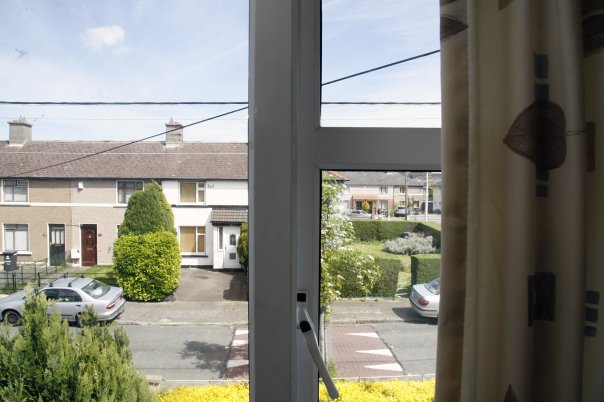
Domestic bliss: the view outside the bedroom/studio
SO’S: Working from home has pushed my practice in new and different directions. In 2004, I was living in a house that had a storefront space I used as a studio. I had been living in Dublin for 2 years, having moved from South Africa, and knew very few visual artists; most of my friends were musicians. I decided to hold a ‘Meet and Dine’ project in the space so that I could meet and interact with artists but also connect my interests in art and activism:
“For the month of April I am inviting creative groups, be they reading groups, event organizers, activists, musicians, gardeners, cooks, or art groups, to make use of a storefront space to have a dinner meeting. Please bring one vegetable and one piece of fruit. Soup and juice will be provided.”
I used the fruit and vegetables brought by one group to feed the next group. In the end, it was mostly activists and community groups that responded. There was one artist reading group. It was good to get a taste of what was happening in the city and to have, for example, a new immigrant community group, feed a group wanting to set up a social centre, feed a community garden group, feed an art reading group.
GK: You’re doing significantly well for yourself, whether you work from home or some ideal studio setting. Does your art production differ in any way when working from an organized studio?
SO’S: Well, I’ve recently managed to get funding and have been awarded studio residencies so I have been able to support and concentrate on my projects and practice.
TRESPASS is a project where my studio/research space has been wasteland spaces in Dublin. Irish artist Aoife Desmond and I began the project in 2005. It started with trespassing in the spaces and initially doing some drawing and photo-based work at the sites. This work emerged from us witnessing the rapid disappearance of these “green” spaces during Dublin’s economic boom. As these spaces disappeared, rents and studio spaces in Dublin went up (laughs). There is a funny correlation between all of this. We were awarded an Arts Council new work award in 2007. We have concentrated on two spaces outside of the Irish Museum of Modern Art over the last two years, making film, research, and photographic-based works, which we recently exhibited at The LAB.
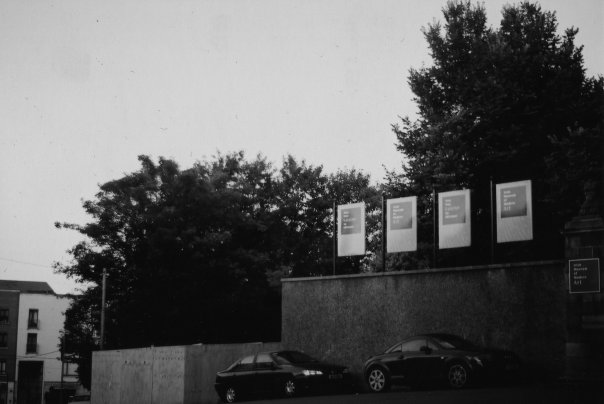
"TRESPASS," 2007. The hoarding surrounding a derelict site beside the Irish Museum of Modern Art.
In 2007, I was awarded Studio 468 in Dublin. This studio is situated in a community centre in one of Dublin’s more disadvantaged areas, Rialto. Part of the residency was to work with a community group for 6 hours a week. I found it strange having a studio, an individual quiet space in a community centre while all the other spaces were communal and shared. I was doing my Masters at the time and researching the cultural challenge that environmental sustainability posed to art. I had been involved in a squatted community garden that had recently been evicted. I decided that it would be great to set up a community garden that linked directly to the community centre. So I began to plant seeds in my studio, which had a large glass front. It was like a greenhouse and incubation space for the seeds and the project. I called a meeting in the studio and found an abandoned green space and got permission to use it for free. The site had planning permission on it for apartment blocks, which was not due to be built for another 2 years. So we have been able to use it in the meantime. Rent and studio spaces in Dublin skyrocketed in the last 10 years with the development boom and Celtic Tiger economy. Now with the economic recession, the chances are that we may have the site for a lot longer. Next year I would like to curate a series of projects by artists responding to the garden. Community gardens are radical spaces. They are collectively organized and run; we grow our own food and they are a place of trust where tasks, produce, and materials are collectively owned and shared.
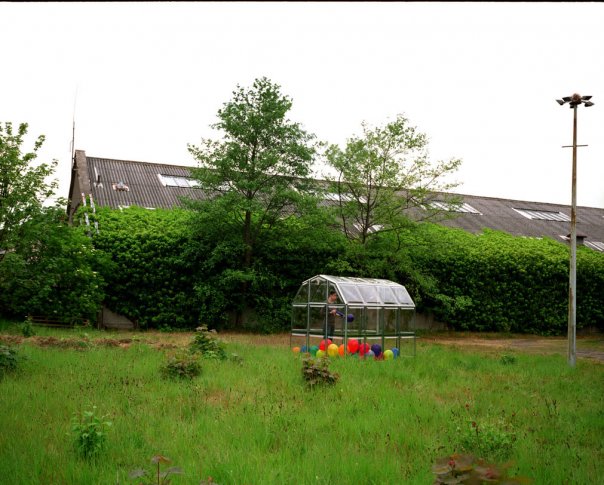
"Collective Dreaming," photo lightbox, 2007. Part of the "Not There Here" installation. Seoidín in the site that became the community garden.
These wasteland spaces will probably now reemerge and artist studio spaces will get cheaper, as there are so many empty apartment blocks in Dublin and the unsustainable building trade has gone bankrupt. TRESPASS did a residency in 2008 as part of Rirkrit Tiravanija’s project, the land’s One Year Project 2. It was good to go and experience this famous relational work firsthand and we responded with Relocated Jungle and a book that maps the wasteland sites around the land’s office in central Chaing Mai.
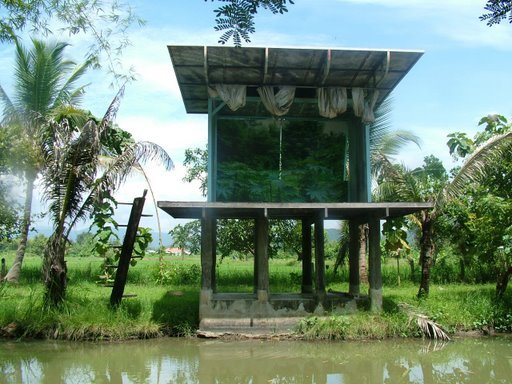
"Relocated Jungle," the land, Thailand. A photograph of a wasteland site in Chiang Mai city was put up in a structure on the land.
My collaborative project TACTIC was awarded an incubation space in The LAB, a Dublin City Council-run artspace, for 6 months beginning in October 2008. This was a large studio in Dublin’s city centre. South African artist Ralph Borland and I used this space to bring artists and activists together for a month of talks, events, and debates during March 2009. Prior to that, I used the space during the other 5 months for TACTIC meetings in the morning and TRESPASS meetings in the afternoon.
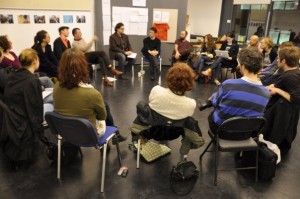
"You stole my idea!" debate on copyright and art in TACTIC's incubation space.
Now I am back in my office/studio space at home.This space is a bit like the engine room of my wider practice. I am applying for funding for the next phase of these projects and work part-time to cover my rent.
GK: One may be critical or skeptical about the office/studio/home model but underneath the initial layer of presuppositions attached to such workspaces, an in-depth look of the works produced within these homey walls may surprise us.
Until next time, that’s a wrap!



